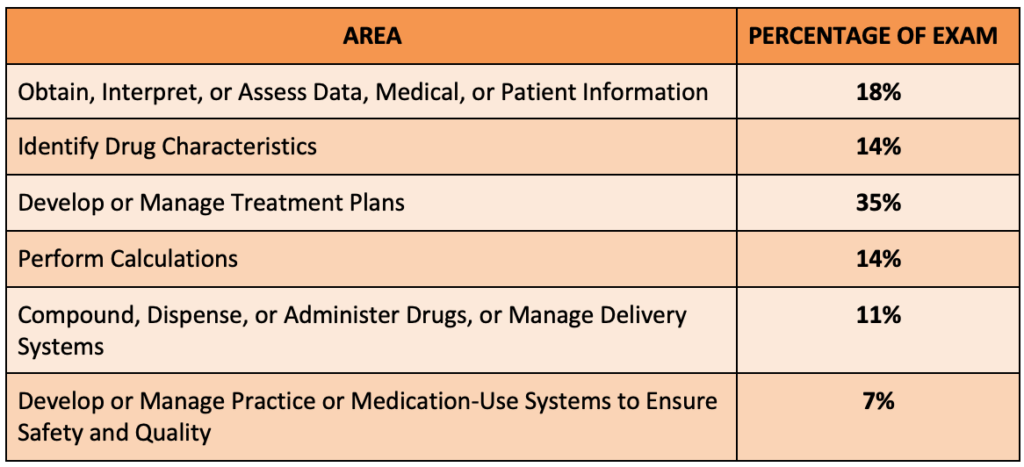
You’ve just finished pharmacy school. You’ve conquered countless exams and challenges, but one final hurdle remains – the North American Pharmacist Licensure Examination® (NAPLEX®). This daunting 6-hour exam is the culmination of your four years of hard work. Passing the NAPLEX® is a crucial step in your career, opening doors to licensure and allowing you to practice as a pharmacist.
The challenge of the NAPLEX® exam is reflected in recent statistics. According to the National Association of Boards of Pharmacy (NABP), the mean first-time pass rates were 81.3% for the Class of 2021, 77.1% for the Class of 2022, and 77.5% for the Class of 2023. Data shows a slight decline in pass rates over the last three years, underscoring the importance of thorough preparation. Understanding the structure of the NAPLEX®, effective study strategies, and tips for exam day will help you approach this challenge with confidence and pass.

Exam Breakdown and Competencies
As you prepare for the NAPLEX®, it’s helpful to know exactly what to expect and how the exam is set up. The NAPLEX® is a 6-hour, computer-based exam with 225 questions. Out of all these questions, 200 will count towards your score and 25 are pretest questions that will be used to evaluate their potential for future exams. You won’t be able to distinguish which are pretest questions, so treat them as if every question is graded on the exam. The majority of the questions will be scenario-based, and you need to answer questions in the order they appear as you will not have the ability to go back after you moved on from a question. For these reasons, make sure you are answering each question carefully!
What will you be tested on? The NAPLEX® will test you on the following key competencies:

A more detailed breakdown can be viewed here and is great to reference when studying.
NAPLEX® results are reported as “Pass” or “Fail” with no numerical score. To pass, you must meet the minimum competency required to practice as a pharmacist. For the latest details on registration, costs, and other important information, visit the NAPLEX® Registration Bulletin for the most up-to-date information.
Exam Study Tips and Helpful Suggestions
Now that you have an idea of how the exam is broken down, let’s go over some tips to help you study effectively.
- Set a study schedule and stick to it.
Start by creating a study schedule that fits your routine. Break your study material into chunks and set achievable goals for each session. Having a plan helps to hold yourself accountable and stay organized, making the whole process feel less overwhelming.
- Perform practice questions regularly.
It’s important to do practice questions regularly and even stimulate exam conditions during the later stages of your studying journey. This will ensure that you will be familiar with the types of questions that may appear on your exam and be able to answer them in a timely fashion. With 225 questions over 6 hours, you’ll have about 1 minute and 30 seconds to spend per question, so make sure you focus on answering quickly and accurately to stay on track during the exam. For comprehensive practice, consider checking out RxPharmacist’s 2024-2025 NAPLEX® Practice Questions course, which offers over 700 questions with up-to-date explanations to help you gain confidence and pass on your first attempt.
- Review your calculations.
Don’t overlook the calculations section! Regular practice can make this section feel like a breeze and save you time on the NAPLEX®. It helps to memorize some basic conversions and standard formulas as well (e.g., creatinine clearance, body mass index, pharmacokinetics). These questions are open responses, meaning you must manually type in your answer, so please be extra mindful about decimal places and rounding .
- Know your brand and generic names.
You’ve probably had class exams where they used brand and generic names interchangeably. Expect the same on the NAPLEX®. You don’t want to miss any points to a question just because you forgot the brand name of a drug. Flashcards and mnemonics are great tools to help you remember medications. Additionally, group study sessions, quizzing with your friends, and associating the names to the drugs’ packaging are great ways to reinforce your memory.
- Understand patient exceptions.
While it is important to know the therapeutic indications for drugs, it’s also crucial to be prepared for specific patient scenarios. For example:
- What if a patient has a drug allergy?
- What if the patient is pregnant?
- What if they have chronic conditions like heart failure or chronic kidney disease?
- What if the patient has failed a first-line treatment in the past?
Having alternative recommendations ready for these situations will help you tackle any tricky questions that may come up.
- Take breaks.
Give yourself regular short breaks to recharge – whether it’s a quick walk, a snack, or a power nap. This keeps your mind fresh and focused, making your study sessions more effective. A popular method is the Pomodoro Technique: study for 25 minutes, then take a 5-minute break. On exam day, you’ll have two optional ten-minute breaks. Use these to your advantage to maintain mental clarity and momentum throughout the exam.
Remember, the NAPLEX® is a challenging exam, but with the right preparation, you can succeed. Stay focused, keep a positive mindset, and trust in your preparation. Good luck studying!
Winnie Chu
RxPharmacist Team
References:
- National Association of Boards of Pharmacy. NAPLEX & MPJE Bulletin. Available from: https://read.nxtbook.com/nabp/bulletin/naplex_mpje_bulletin/cover.html. Accessed July 22, 2024.
- National Association of Boards of Pharmacy. NAPLEX Competency Statements. Available from: https://nabp.pharmacy/programs/examinations/naplex/competency-statements/. Accessed July 22, 2024.
- National Association of Boards of Pharmacy. NAPLEX. Available from: https://nabp.pharmacy/programs/examinations/naplex/. Accessed July 22, 2024.
- National Association of Boards of Pharmacy. NAPLEX Pass Rates 2023. Available from: https://nabp.pharmacy/wp-content/uploads/NAPLEX-Pass-Rates-2023.pdf. Accessed July 22, 2024.
